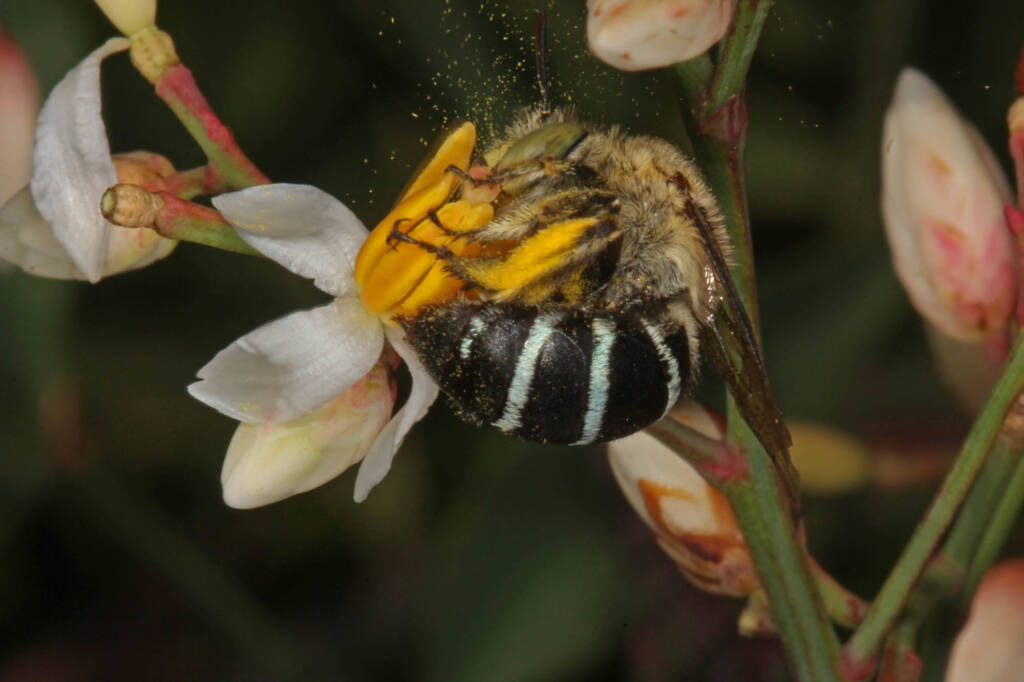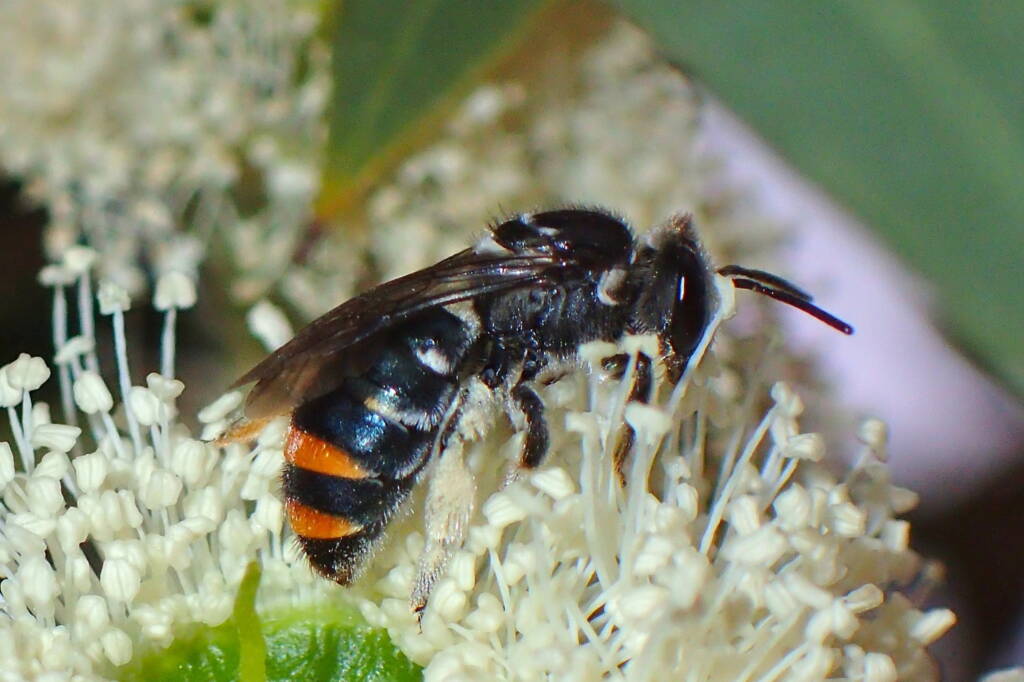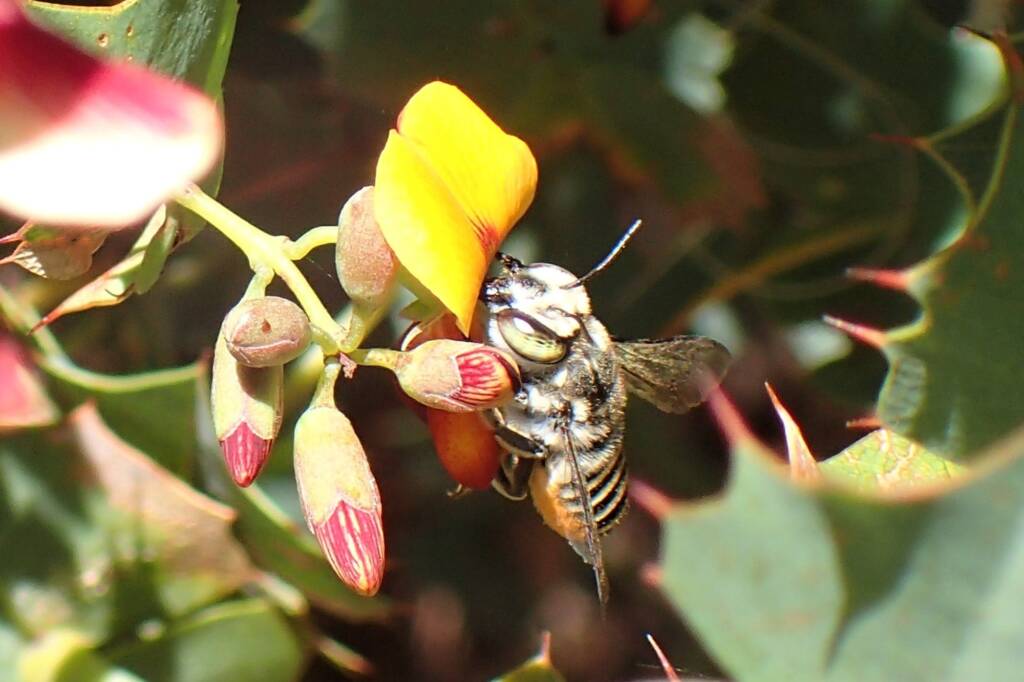Bee BehaviourBubbling Bees Buzz Pollination Operculum lifting behaviour
One of the characteristics of a bee that is buzz pollinating is that you usually see it hunched over the anthers of the flower with the the folded wings sticking out.
It is thought that many of the species of the genus Lipotriches are buzz pollinators.

In the following image of Xylocopa (Lestis) aeratus on Nandina, the blurry head indicates that this species also performs the “head banging buzz pollination” as has been discovered for Blue Banded Bees. Research has found that buzz pollinators can head-bang flowers up to 350 times a second.

An example can be viewed here:
High-speed headbanging bees | RMIT University, Callin Switzer, Adelaide Botanic Gardens, https://www.youtube.com/watch?v=4SmJdVxZ_Lw

Lipotriches (Austranomia) australicus, another one of my favourites that I reckon doesn’t get the “airtime” that she deserves. You’ll often see posts of male Lipotriches, fairly drably dressed in faded flannel compared the girls, and all they do (when they’re not chasing chicks) is hang out together at the local stick, no doubt bragging about their conquests… But this girl, like the Blue banded bees (Amegilla) is in the exclusive “buzz pollinator” club. And I should point out that this girl was in shadow when I took these pics… when the sunlight hits those black bands at the right angle they turn an incredible deep metallic blue and she makes the Blue banded bees look utterly plain…
But what’s “buzz pollination” and where do “poricidal anthers ” come in? Well, to put it simply, there’s a lot of bugs out there that feed on pollen but all they do is eat it, they don’t actually help much with the pollination process. Some plants got a bit fed up with being “robbed” so instead of producing their pollen where it was freely accessible to anyone, they developed sac like structures around their pollen that had small openings or pores (hence the name “poricidal anthers”), that were too small to let bugs in but big enough to let the pollen out… provided it was shaken at the right frequency… and that is something only some of our native bees (that would have evolved alongside those plants hundreds of millions of years ago) can do and why they are so important to our unique Aussie ecosystem
Author Gary Taylor
Megachile macularis I’d reckon, I put the three up ‘cos although she’s not a “buzz pollinator” as such she still shakes it up on the dance floor… First pic she lands, sets herself up, thanks girl, think I got that one, second and third pics she doesn’t seem to be doing much but check out the pollen that’s bursting up around her… You might need to click on the pic to see it, and when you do, notice how everything else is in focus (as she is in the first pic) but in these two she’s slightly out… almost like she’s vibrating at a really high frequency, a bit like buzz pollination… 🙂 And you can see she has her jaws sunk into the flower, holding her head steady…
Author Gary Taylor
What defines buzz pollination, head-banging or body vibration…
These pics (above) of Eutricharaea apparently buzz pollinating. Notice how her jaws are locked on to the flower, which I believe is to transfer the vibrations of the body to the flower. A study was done some years back into Amegilla buzz pollinating, in all the photos they had of it, it’s head was always out of focus but the rest of the body was fine… so they did a high speed film of it and found it was actually banging it’s head against the flower… Surely simply holding the flower in your jaws while vibrating your head would have a similar effect…
Author Gary Taylor
Check out our blog The “buzz pollination” club by Gary Taylor.
This page is a work in progress…
Footnote & References
- Photographs © Marc Newman, Flickr, https://flickr.com/photos/koolbee/albums
- Photographs and content contribution by Gary Taylor, Western Australia
- Bees, Buzz-pollination of Hibbertia obtusifolia by Australian native bees – a comparative study of bee buzzing behaviour in Capertee Valley, New South Wales, author Vicki Powys, https://caperteebirder.com/?page_id=35
BeesBees Anatomy Bee Behaviour Blogging Bees… Bees – image index Amegilla Bee Apis mellifera Austroplebeia australis Austrothurgus Braunsapis sp Ceylalictus perditellus Colletidae Euryglossinae Exoneura Homalictus Hyleoides bivulnerata Lasioglossum Lasioglossum (Chilalictus) Lipotriches Megachile Meroglossa Stenotritidae Tetragonula Thyreus Xylocopa
Bee BehaviourBubbling Bees Buzz Pollination Operculum lifting behaviour






